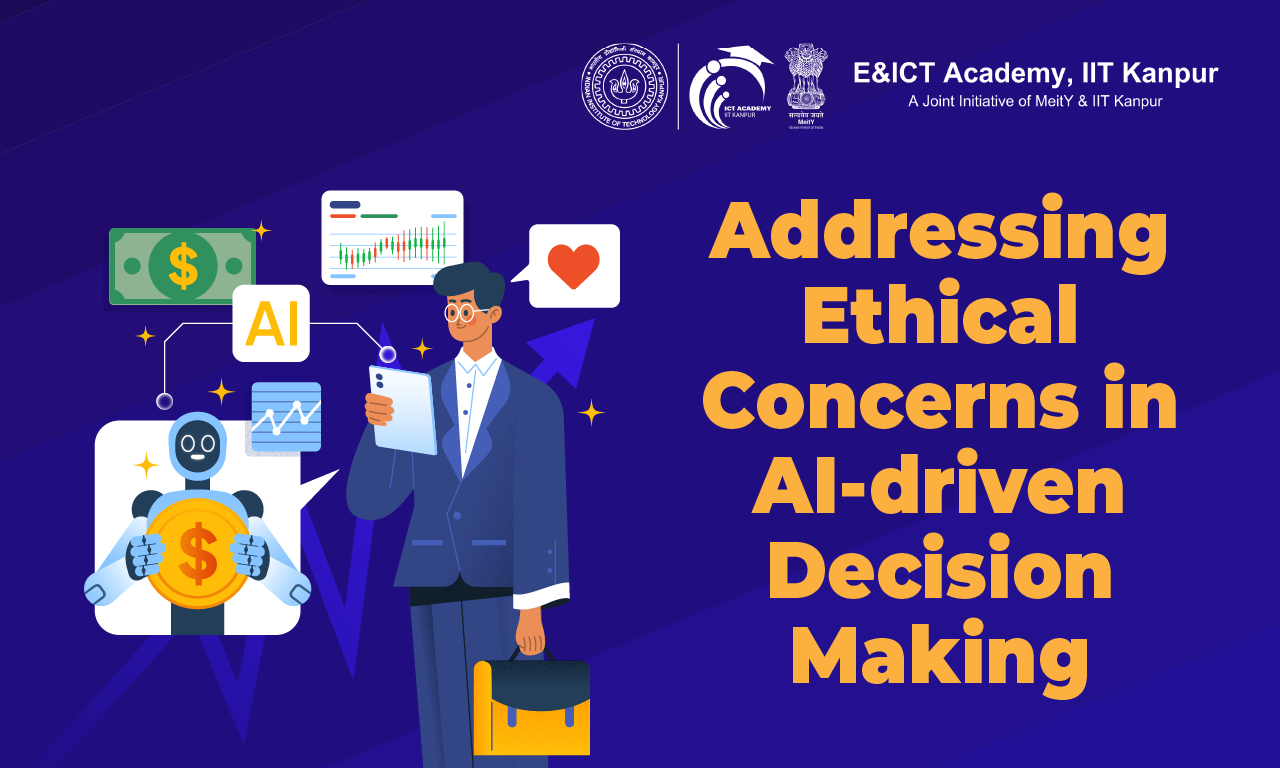Addressing Ethical Concerns in AI-Driven Decision Making: Fairness, Accountability, and Transparency

The potential hazards and repercussions of using artificial intelligence systems to make decisions that affect people, societies, and different facets of human life give rise to ethical considerations in AI-driven decision-making. These are some of the main ethical issues:
1: Discriminatory outcomes might result from biases that AI systems can inherit from the data they are trained on. When generating decisions, the AI system may reinforce or even amplify any biases included in the training data.
2: Lack of Transparency: Deep neural networks, one type of AI model, can be challenging to read and comprehend. Accountability issues arise from this lack of openness since it becomes difficult to understand how and why a particular choice was made. This opaqueness can make it more difficult for people to contest or appeal rulings.
3: Privacy and security: In order for AI systems to make reliable choices, they frequently need access to a lot of personal data. There are issues with the way that this data is gathered, kept, and applied. Personal data can be misused, hacked, or subject to unauthorized access if it is not adequately protected, putting people’s privacy and security at risk.
4: Accuracy and Reliability: AI models are flawed and subject to mistakes. Decisions that are made entirely by AI without human scrutiny or intervention may be flawed or unfair. To preserve accuracy and dependability, it is essential to make sure AI systems are fully tested, validated, and frequently updated.
5: Automation of Important Decisions: As AI systems advance, there is rising worry about their potential to automate important decisions that have a big influence on society, like those involving hiring, criminal justice, healthcare, and loan approvals. These judgments are made without human input, which raises concerns about fairness, responsibility, and the possibility of unexpected effects.
6: The rising adoption of AI-driven systems may result in job displacement and socioeconomic implications, such as higher unemployment. Certain occupational roles may be eliminated by automation, which could cause unemployment for some employees and widen social gaps. For those who are impacted, ensuring a fair transition and retraining programs becomes crucial.
7: Influence: AI systems can be used to distribute misinformation, influence public opinion, or conduct surveillance. AI algorithms can be used by malicious actors to produce deep fakes, launch specialized propaganda campaigns, or infringe privacy. This prompts questions about possible AI technology abuse and the necessity of strong security measures.
Experts from a variety of disciplines, including computer science, ethics, law, and social sciences, are needed to address these ethical issues. Ensuring that AI is beneficial to society while minimizing any potential risks, entails creating transparent and accountable AI systems, establishing rules and standards, encouraging diversity and inclusivity in AI development, and participating in public conversation.
Fairness:
Fairness is a critical ethical consideration in decision-making that is AI-driven. Prevent prejudice or discrimination in AI systems’ decision-making, it refers to the fair treatment of both individuals and groups. Here are a few characteristics of AI fairness:
1: Algorithmic Bias: In AI systems, bias can appear when the training data reflect social biases that already exist or when the algorithms themselves behave in a biased manner. Certain people or groups may experience discriminatory effects as a result of this. To ensure that everyone receives the same treatment and opportunity, fairness necessitates recognizing and eliminating these biases.
2: Protected Attributes: Fairness involves avoiding discrimination based on protected attributes such as race, gender, age, religion, sexual orientation, or disability. AI systems should not perpetuate or amplify existing biases related to these attributes, and decisions should be made solely based on relevant and non-discriminatory factors.
3: Procedural Fairness: The decision-making process itself should be fair and transparent. This means individuals should have the right to understand how decisions are made, the criteria involved, and the opportunity to appeal or contest decisions. Clear guidelines and explanations should be provided to ensure accountability and build trust.
4: Group Fairness: Fairness extends beyond individual-level considerations. AI systems should not systematically disadvantage or marginalize certain groups or communities. Group fairness involves examining the impact of AI decisions on different demographic groups and ensuring that outcomes are equitable across these groups.
5: Fair Data Collection: Fairness also encompasses the collection and use of data. Biased or unrepresentative data can lead to unfair outcomes. It is essential to ensure that data collection methods are unbiased, and representative, and do not reinforce existing inequalities or discriminatory practices.
6: Fairness should be taken into account in the unique context in which AI technologies are used. To prevent disproportionate effects on particular groups or the persistence of historical biases, various sectors, such as healthcare, criminal justice, or hiring, have specific fairness issues that call for careful attention.
7: Addressing fairness in AI systems involves a combination of technical and societal measures. It requires designing algorithms that are explicitly trained to be fair, developing evaluation metrics and benchmarks to assess the fairness, and considering the ethical and legal implications throughout the AI development lifecycle. Additionally, diverse and inclusive teams working on AI development can help mitigate biases and improve fairness by considering different perspectives and experiences. Ultimately, fairness in AI-driven decision-making is an ongoing effort that requires continuous monitoring, evaluation, and iterative improvements to ensure equitable outcomes for all.
Accountability:
A key component of ethical AI-driven decision-making is accountability. It speaks about the accountability and responsibility of people, groups, and AI systems for the choices and actions they make. Accountability aids in ensuring that the dangers and repercussions that AI systems may cause are adequately addressed. The following are some crucial components of AI accountability:
1: Specifying who is in charge of the design, development, and deployment of AI systems is necessary for accountability. This entails establishing distinct lines of authority and responsibility as well as defining the roles and duties of people and organizations involved in developing and administering AI systems.
2: Transparency and Explainability: AI systems ought to be created in a transparent and comprehensible manner. Information regarding how the system operates, what data it uses, and how it makes choices should be available to users and stakeholders. AI judgments made by systems can be better understood with the use of explainable AI (XAI) approaches.
3: Validation and Auditing: Regular validation and auditing procedures are crucial for evaluating the efficacy, justice, and moral implications of AI systems. This entails keeping an eye on and assessing the system’s actions, data inputs, and decision-making procedures to make sure they adhere to moral and ethical norms.
4: Redress and Appeals: Individuals affected by AI-driven decisions should have avenues for redress and the ability to appeal or challenge decisions. Establishing mechanisms for individuals to request reconsideration, provide additional information, or lodge complaints helps ensure that decisions made by AI systems can be reviewed and corrected if necessary.
5: Legal and Regulatory Frameworks: Accountability in AI is reinforced through legal and regulatory frameworks. Governments and organizations are increasingly developing policies, laws, and regulations that govern the use of AI and outline the responsibilities of various stakeholders. Compliance with these frameworks is important to ensure accountability and address potential risks and harms.
6: Legal and Regulatory Frameworks: Accountability in AI is reinforced through legal and regulatory frameworks. Governments and organizations are increasingly developing policies, laws, and regulations that govern the use of AI and outline the responsibilities of various stakeholders. Compliance with these frameworks is important to ensure accountability and address potential risks and harms.
7: Ethical Principles and Codes of Conduct: The creation and adoption of AI-specific ethical principles and codes of conduct can encourage accountability. These recommendations can serve as principles and best practices for the ethical design, development, and use of AI systems, ensuring that they are consistent with accepted moral standards and societal values.
8: Establishing independent ethical review committees or boards can aid in analyzing and keeping track of the ethical consequences of AI systems. These organizations can offer direction, study new AI initiatives, and assess their possible hazards, moral issues, and compliance with pertinent laws.
Transparency:
A crucial component of ethical AI-driven decision-making is transparency. It alludes to the transparency and openness of data of the structure, operation, and decision-making procedures of AI systems. Transparent AI systems allow users and stakeholders to understand and assess the system’s behavior while also promoting accountability. Aspects of AI transparency include the following:
1: Model and Method Transparency: To be transparent, information regarding the AI model and algorithms applied to decision-making must be accessible. This covers information on the architecture’s foundation, the training data utilized, preprocessing methods, and the overall decision-making process. Gaining insight into how the system makes decisions fosters confidence and improves evaluations of its fairness and dependability.
2: Data Transparency: Since AI systems rely on data, it is important to be transparent about the sources, collection processes, and preprocessing steps used. This covers information on data biases, potential restrictions, and any mitigation measures. Transparent data practices guarantee that data is used ethically, in a way that respects privacy, and without contributing to the resurgence of discrimination.
3: Explainability: Transparent AI systems ought to be able to give comprehensible justifications for their choices and actions. Users and stakeholders can better understand the variables that the AI system took into account when coming to its conclusions by using explainability approaches like highlighting the relevant aspects, indicating feature importance, or presenting decision rules.
4: Reporting and documentation: Transparent AI systems should contain detailed documentation that explains the system’s capabilities, restrictions, and any dangers. Accountability is encouraged and external examination is made possible by reporting on the effectiveness and impact of AI systems, including accuracy, bias, and any faults or mitigations that have been found.
5: Collaboration and Open Source: Open-source AI frameworks and tools promote transparency by enabling developers and researchers to look into and validate the operation of AI systems. Within the AI community, collaboration and sharing of best practices, techniques, and knowledge fosters openness and fosters a community-wide understanding and improvement.
6: User interfaces and communication: User interfaces for transparent AI systems should clearly explain to users the system’s capabilities, constraints, and potential uncertainties. User expectations can be managed with the help of clear and understandable communication, which also ensures that users can base their decisions on the outputs of the AI system with knowledge.
7: Independent Auditing and Certification: Processes for independent auditing and certification can evaluate the ethics and openness of AI systems. Transparency, fairness, and adherence to moral principles and laws can all be evaluated objectively by third-party audits, certifications, and assessments.
Combining technical measures, documentation procedures, and organizational regulations can increase openness in AI-driven decision-making. Making sure that openness is prioritized throughout the AI development lifecycle, requires the involvement of AI developers, academics, policymakers, and other stakeholders. Enhancing transparency will make AI systems easier to comprehend, assess, and hold accountable, promoting trust and the moral application of AI technology.
Recommended Courses

Advanced Certificate Program in AI for Leaders

AI & Digital Transformation

AI for Managers

AI for Managers

Artificial Intelligence

Data Analytics using AI

Deep Learning with Generative AI for Computer Vision

Generative AI

Generative AI Course

Machine Learning with Python

Professional Certificate Course in Generative AI and Machine Learning

Professional Certificate Program in Leadership with AI



